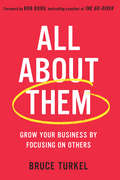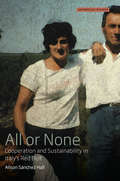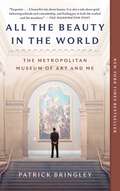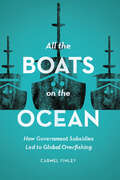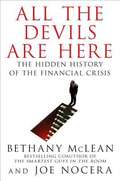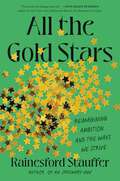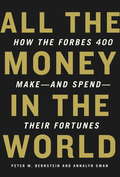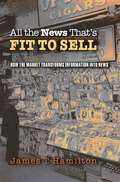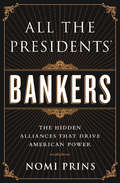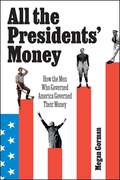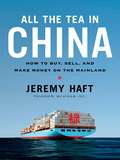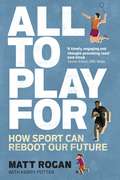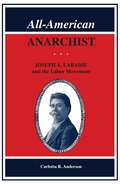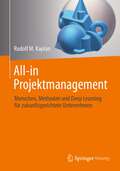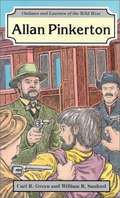- Table View
- List View
All Your Worth
by Elizabeth Warren Amelia Warren TyagiYou work hard -- really hard -- but it seems like there's never enough. Never enough to cover all the bills. Never enough to relax and have some fun. Never enough to save some real money. What has gone wrong? What is the secret that you haven't figured out? In All Your Worth, Elizabeth Warren and Amelia Warren Tyagi -- mother/daughter authors of the acclaimed The Two-Income Trap -- tell you the truth about money. They lay out the new rules of money -- the ones nobody talks about. They show you how to get out of debt, cover your bills, and start getting ahead -- without needing to carry a calculator everywhere you go. All Your Worth will help you get control over your money once and for all so that you can finally start building toward the life you've always wanted. All Your Worth isn't based on lucky guesses or gut reasoning; it is the result of more than twenty years of intensive research. As a result, the authors don't offer you a few quick fixes destined to fall apart, and they don't waste time trying to solve problems you don't have. Instead, the authors lay out a breakthrough approach for getting control over your money. And they use this approach to help you conquer your financial problems, step by step. They help you create a plan that isn't just for a week or for a month; this is a plan that lets you master your money for the rest of your life. The secret? It's simple, really: Get your money in balance. Warren and Tyagi show you how to divide and conquer. You will learn to balance your money into three essential parts: the Must-Haves (the bills you have to pay month after month), the Wants (some fun money for right now), and your Savings (so you can build a better tomorrow). No complicated budgets, and no keeping track of every penny you spend. Once you have the basics, it gets easy. You can put your money worries behind you and get on with what really matters -- living your life. Whatever your struggles with money, Warren and Tyagi can help you get your finances on the right track. They will show you things about yourself that you have never quite seen. Are you an emotional spender? Is debt robbing your future? Do you spend too little on fun? Are you and your partner trapped in the Money Blame Game? After you read this book, you will never look at your money -- or yourself -- in quite the same way again. Whether you are knee-deep in past-due notices or you just don't think you're saving enough, money worries can chew away at your life. Warren and Tyagi are here to tell you that you can stop the worry. You can change it all. You can have enough -- enough to cover the necessities, enough to put some real money in the bank and start bringing your dreams into reach. You can even have enough money to have fun. (In fact, they insist that you have enough for fun!) Best of all, with All Your Worth, you can have peace of mind for the rest of your life.
All about Them: Grow Your Business by Focusing on Others
by Bob Burg Bruce TurkelThe best companies and most successful salespeople live by a three-word mantra—"all about them"—because when they relentlessly focus their brand on their customers instead of themselves, their businesses flourish. All about Them shows readers how to use this simple but extremely powerful influencing technique. Bruce Turkel, who has advised some of the world's greatest companies, including American Express and Bacardi, lays the groundwork by relating his personal journey of discovery to the "All about Them" principle. He goes on to explore our technology-driven, hyper- connected culture; the power of storytelling (and story-selling); brand authenticity and transparency; and more.
All about the Burger: A History of America's Favorite Sandwich
by Sef GonzalezFrom conception to perfection, a complete history of the hamburger, for fans of Mark Kurlansky, Tom Standage, Jared Diamond, and Bee Wilson. Discover the food history you've been missing in this entertaining book. Do you know what the first burger chain was? That Taco Bell was originally known as Bell Burger—and was founded in the same city as McDonald's? Have you heard of the 1980s Burger Wars? All About the Burger covers all these topics and more…All About the Burger will take you on the burger journey of a lifetime, an informational magic carpet ride. You&’ll learn about restaurants, cooking styles, and different eras that have made the burger the juggernaut that it is. From White Castle to Shake Shack, from simple sandwich to specialty burger, you won&’t miss a bite. This is the definitive Bible of Burgers. After reading this book, you will learn:· The contributions burgers have made to food culture· The evolution of the burger from carnival treat to an American staple· Where to go to find your next favorite burger· And much more!Praise for All about the Burger &“Sef&’s pursuit of the real story, along with the way he writes about the histories of these storied American restaurants and companies, truly conveys the respect and love he has for the subject.&”―Bob Gatewood and Brian Easley, president & vice president at Druther&’s &“A book so meticulously researched and passionately written, it is the crowning achievement of one of our greatest food authorities. You will devour it instantly.&”―Lee Schrager, Food Network&’s South Beach Wine & Food Festival, founder
All or None: Cooperation and Sustainability in Italy's Red Belt (Anthropology of Europe #3)
by Alison Sánchez HallAt once a social history and anthropological study of the world’s oldest voluntary collective farms, All or None is a story of how landless laborers joined together in Ravenna, Italy to acquire land, sometimes by occupying private land in what they called a “strike in reverse,” and how they developed sophisticated land use plans, based not only on the goal of profit, but on the human value of providing work where none was available. It addresses the question of the viability of cooperative enterprise as a potential solution for displaced workers, and as a more humane alternative to capitalist agribusiness.
All the Beauty in the World: The Metropolitan Museum of Art and Me
by Patrick BringleyNew York Times bestseller Named one of the best books of the year by the New York Public Library, the Financial Times, the New York Post, Book Riot, and The Sunday Times (London). An &“exquisite&” (The Washington Post) &“hauntingly beautiful&” (Associated Press) portrait of the Metropolitan Museum of Art and its treasures by a former New Yorker staffer who spent a decade as a museum guard.Millions of people climb the grand marble staircase to visit the Metropolitan Museum of Art every year. But only a select few have unrestricted access to every nook and cranny. They&’re the guards who roam unobtrusively in dark blue suits, keeping a watchful eye on the two million square foot treasure house. Caught up in his glamourous fledgling career at The New Yorker, Patrick Bringley never thought that he&’d be one of them. Then his older brother was diagnosed with fatal cancer and he found himself needing to escape the mundane clamor of daily life. So he quit The New Yorker and sought solace in the most beautiful place he knew. To his surprise and your delight, this temporary refuge becomes Bringley&’s home away from home for a decade. We follow him as he guards delicate treasures from Egypt to Rome, strolls the labyrinths beneath the galleries, wears out nine pairs of company shoes, and marvels at the beautiful works in his care. Bringley enters the museum as a ghost, silent and almost invisible, but soon finds his voice and his tribe: the artworks and their creators and the lively subculture of museum guards—a gorgeous mosaic of artists, musicians, blue-collar stalwarts, immigrants, cutups, and dreamers. As his bonds with his colleagues and the art grow, he comes to understand how fortunate he is to be walled off in this little world, and how much it resembles the best aspects of the larger world to which he gradually, gratefully returns. In the tradition of classic workplace memoirs like Lab Girl and Working Stiff, All the Beauty in the World is an &“empathic&” (The New York Times Book Review), &“moving&” (NPR), &“consoling, and beautiful&” (The Guardian) portrait of a great museum, its hidden treasures, and the people who make it tick, by one of its most intimate observers.
All the Boats on the Ocean: How Government Subsidies Led to Global Overfishing
by Carmel FinleyMost current fishing practices are neither economically nor biologically sustainable. Every year, the world spends $80 billion buying fish that cost $105 billion to catch, even as heavy fishing places growing pressure on stocks that are already struggling with warmer, more acidic oceans. How have we developed an industry that is so wasteful, and why has it been so difficult to alter the trajectory toward species extinction? In this transnational, interdisciplinary history, Carmel Finley answers these questions and more as she explores how government subsidies propelled the expansion of fishing from a coastal, in-shore activity into a global industry. While nation states struggling for ocean supremacy have long used fishing as an imperial strategy, the Cold War brought a new emphasis: fishing became a means for nations to make distinct territorial claims. A network of trade policies and tariffs allowed cod from Iceland and tuna canned in Japan into the American market, destabilizing fisheries in New England and Southern California. With the subsequent establishment of tuna canneries in American Samoa and Puerto Rico, Japanese and American tuna boats moved from the Pacific into the Atlantic and Indian Oceans after bluefin. At the same time, government subsidies in nations such as Spain and the Soviet Union fueled fishery expansion on an industrial scale, with the Soviet fleet utterly depleting the stock of rosefish (or Pacific ocean perch) and other groundfish from British Columbia to California. This massive global explosion in fishing power led nations to expand their territorial limits in the 1970s, forever changing the seas. Looking across politics, economics, and biology, All the Boats on the Ocean casts a wide net to reveal how the subsidy-driven expansion of fisheries in the Pacific during the Cold War led to the growth of fisheries science and the creation of international fisheries management. Nevertheless, the seas are far from calm: in a world where this technologically advanced industry has enabled nations to colonize the oceans, fish literally have no place left to hide, and the future of the seas and their fish stocks is uncertain.
All the Brains in the Business: The Engendered Brain in the 21st Century Organisation (The Neuroscience of Business)
by Paul Brown Kate LanzThe power of gender difference, not gender equality, is a secret source for success. Some smart businesses are starting to wake up to this fact. This book explores why and how. Properly valuing brain gender diversity in the workplace is one of the biggest and largely untapped sources of competitive advantage for modern businesses. Recent advances in neuroscience provide the key to unlocking it. Modern research shows that there are gender-based differences in the brain – it’s just not as simple as a binary between a ‘male brain’ and ‘female brain’. In fact, our brains are like a mosaic where many of the tiles are available in thousands of shades on a spectrum between pink and blue. The problem is that our workplaces tend to be governed by structures, processes and cultures that are practically pure blue. All the brains in the business that are elsewhere on the spectrum cannot thrive as they might, so sources of productivity, creativity and agility go untapped. Anyone who manages people needs to understand how the brain works and the impact it has on how people work together as teams. Anyone who wants to unlock the talent and productivity of all of their people needs to understand how recent findings around male- and female-type brains should shape the way they manage. Leading applied neuroscientists and international corporate coaches Kate Lanz and Paul Brown show you why and how to access all the brains in your business.
All the Centurions: The Real "Prince of the City" Tells His Story
by Robert LeuciThe bestselling book and acclaimed film Prince of the City told only part of Robert Leuci's story. In All the Centurions, he shares the full account of his years as a narcotics detective with the New York Police Department -- a tale of daring adventure, shattered illusions, and finally, astonishing spiritual growth.Leuci reminisces about cops both celebrated and notorious, like Frank Serpico, Sonny Grosso, and Frank King from the French Connection case. Also here are politicians, Mafia figures, corrupt defense lawyers, and district attorneys, including a young Rudolph Giuliani. Leuci reveals the dark side of the criminal justice system: the bitterness, greed, cruelty, and ambition that eventually overflowed into the streets, precinct houses, and courtrooms of the city.As vivid and entertaining as the best crime novels, All the Centurions is the story of a man descending into a hell of his own making who ultimately finds his way out through truth and justice.
All the Devils Are Here: The Hidden History of the Financial Crisis
by Bethany Mclean Joe NoceraAs soon as the financial crisis erupted, the finger-pointing began. Should the blame fall on Wall Street, Main Street, or Pennsylvania Avenue? On greedy traders, misguided regulators, sleazy subprime companies, cowardly legislators, or clueless home buyers?<P><P> According to Bethany McLean and Joe Nocera, two of America's most acclaimed business journalists, the real answer is all of the above-and more. Many devils helped bring hell to the economy. And the full story, in all of its complexity and detail, is like the legend of the blind men and the elephant. Almost everyone has missed the big picture. Almost no one has put all the pieces together.<P> All the Devils Are Here goes back several decades to weave the hidden history of the financial crisis in a way no previous book has done. It explores the motivations of everyone from famous CEOs, cabinet secretaries, and politicians to anonymous lenders, borrowers, analysts, and Wall Street traders. It delves into the powerful American mythology of homeownership. And it proves that the crisis ultimately wasn't about finance at all; it was about human nature.<P> Among the devils you'll meet in vivid detail:<P> * Angelo Mozilo, the CEO of Countrywide, who dreamed of spreading homeownership to the masses, only to succumb to the peer pressure-and the outsized profits-of the sleaziest subprime lending.<P> * Roland Arnall, a respected philanthropist and diplomat, who made his fortune building Ameriquest, a subprime lending empire that relied on blatantly deceptive lending practices.<P> * Hank Greenberg, who built AIG into a Rube Goldberg contraption with an undeserved triple-A rating, and who ran it so tightly that he was the only one who knew where all the bodies were buried.<P> * Stan O'Neal of Merrill Lynch, aloof and suspicious, who suffered from "Goldman envy" and drove a proud old firm into the ground by promoting cronies and pushing out his smartest lieutenants.<P> * Lloyd Blankfein, who helped turn Goldman Sachs from a culture that famously put clients first to one that made clients secondary to its own bottom line.<P> * Franklin Raines of Fannie Mae, who (like his predecessors) bullied regulators into submission and let his firm drift away from its original, noble mission.<P> * Brian Clarkson of Moody's, who aggressively pushed to increase his rating agency's market share and stock price, at the cost of its integrity.<P> * Alan Greenspan, the legendary maestro of the Federal Reserve, who ignored the evidence of a growing housing bubble and turned a blind eye to the lending practices that ultimately brought down Wall Street-and inflicted enormous pain on the country.<P> Just as McLean's The Smartest Guys in the Room was hailed as the best Enron book on a crowded shelf, so will All the Devils Are Here be remembered for finally making sense of the meltdown and its consequences.
All the Devils Are Here: The Hidden History of the Financial Crisis
by Bethany Mclean Joe Nocera"Hell is empty, and all the devils are here." -Shakespeare, The TempestAs soon as the financial crisis erupted, the finger-pointing began. Should the blame fall on Wall Street, Main Street, or Pennsylvania Avenue? On greedy traders, misguided regulators, sleazy subprime companies, cowardly legislators, or clueless home buyers?According to Bethany McLean and Joe Nocera, two of America's most acclaimed business journalists, the real answer is all of the above-and more. Many devils helped bring hell to the economy. And the full story, in all of its complexity and detail, is like the legend of the blind men and the elephant. Almost everyone has missed the big picture. Almost no one has put all the pieces together.All the Devils Are Here goes back several decades to weave the hidden history of the financial crisis in a way no previous book has done. It explores the motivations of everyone from famous CEOs, cabinet secretaries, and politicians to anonymous lenders, borrowers, analysts, and Wall Street traders. It delves into the powerful American mythology of homeownership. And it proves that the crisis ultimately wasn't about finance at all; it was about human nature.Among the devils you'll meet in vivid detail:* Angelo Mozilo, the CEO of Countrywide, who dreamed of spreading homeownership to the masses, only to succumb to the peer pressure-and the outsized profits-of the sleaziest subprime lending.* Roland Arnall, a respected philanthropist and diplomat, who made his fortune building Ameriquest, a subprime lending empire that relied on blatantly deceptive lending practices.* Hank Greenberg, who built AIG into a Rube Goldberg contraption with an undeserved triple-A rating, and who ran it so tightly that he was the only one who knew where all the bodies were buried.* Stan O'Neal of Merrill Lynch, aloof and suspicious, who suffered from "Goldman envy" and drove a proud old firm into the ground by promoting cronies and pushing out his smartest lieutenants.* Lloyd Blankfein, who helped turn Goldman Sachs from a culture that famously put clients first to one that made clients secondary to its own bottom line.* Franklin Raines of Fannie Mae, who (like his predecessors) bullied regulators into submission and let his firm drift away from its original, noble mission.* Brian Clarkson of Moody's, who aggressively pushed to increase his rating agency's market share and stock price, at the cost of its integrity.* Alan Greenspan, the legendary maestro of the Federal Reserve, who ignored the evidence of a growing housing bubble and turned a blind eye to the lending practices that ultimately brought down Wall Street-and inflicted enormous pain on the country.Just as McLean's The Smartest Guys in the Room was hailed as the best Enron book on a crowded shelf, so will All the Devils Are Here be remembered for finally making sense of the meltdown and its consequences.
All the Gold Stars: Reimagining Ambition and the Ways We Strive
by Rainesford StaufferFrom journalist and author of An Ordinary Age, an examination, dismantling, and reconstruction of ambition, where burnout is the symptom of our holiest sin: the lonely way we strive. Ambition—the want, the hunger, the need to achieve—is woven into America&’s fabric from the first colonization to capitalism. From our first gold star assignment to acceptance at the &“right&” college to hustle and grinding our lives, we celebrate our drive, even as we gatekeep who is permitted to strive--and how visibly. Even as we burn out. When we can&’t even. When we know: work won&’t love us back.All the Gold Stars looks at how the cultural, personal, and societal expectations around ambition are driving the burnout epidemic by funneling our worth into productivity, limiting our imaginations, and pushing us further apart. Through the devastating personal narrative of her own ambition crisis, Stauffer discovers the common factors driving us all, peeling back layers of family expectations, capitalism, and self-esteem that dangerously tie up our worth in our output. Interviews with students, parents, workers, psychologists, labor organizers, and more offer a new definition of ambition and the tools to reframe our lives around true success. All the Gold Stars provides ways for us to reject our current reality and reconceive ambition as more collective, imaginative, and rooted in caring for ourselves and each other.
All the Math You'll Ever Need: A Self-Teaching Guide (Wiley Self-Teaching Guides #148)
by Carolyn C. Wheater Steve SlavinA comprehensive and hands-on guide to crucial math concepts and terminology In the newly revised third edition of All the Math You’ll Ever Need: A Self-Teaching Guide, veteran math and computer technology teacher Carolyn Wheater and veteran mathematics author Steve Slavin deliver a practical and accessible guide to math you can use every day and apply to a wide variety of life tasks. From calculating monthly mortgage payments to the time you’ll need to pay off a credit card, this book walks you through the steps to understanding basic math concepts. This latest edition is updated to reflect recent changes in interest rates, prices, and wages, and incorporates information on the intelligent and efficient use of calculators and mental math techniques. It also offers: A brand-new chapter on hands-on statistics to help readers understand common graphs An easy-to-use-format that provides an interactive method with frequent questions, problems, and self-tests Complete explanations of necessary mathematical concepts that explore not just how math works, but also why it worksPerfect for anyone seeking to make practical use of essential math concepts and strategies in their day-to-day life, All the Math You’ll Ever Need is an invaluable addition to the libraries of students who want a bit of extra help applying math in the real world.
All the Money in the World: How the Forbes 400 Make--and Spend--their Fortunes
by Annalyn Swan Peter W. BernsteinPublished to coincide with the twenty-fifth anniversary of the Forbes 400, All the Money in the World,the work of a team of prominent editors and business writers, goes behind the celebrated list to paint a vivid and revealing portrait of the wealthiest Americans of the past quarter century. Abundantly anecdotal, with insights gleaned from original research, interviews with Forbes 400 members, and never-before-compiled data, it is filled with illuminating "infographics"--tables, sidebars, factoids. The book shows how the superrich succeed, how fortunes are made in various industries, and how, once made, they are saved, enhanced, and sometimes squandered. From Wall Street to the West Coast, from blue-collar billionaires to blue-blood fortunes, from the Google guys to hedge fund honchos, All the Money in the World gives us the lowdown on, among other things: the all-time richest Americans, who made and lost the most money in the past twenty-five years, the fields and industries that have produced the greatest wealth, the biggest risk takers, the most competitive players, the most wasteful family feuds, the trophy wives, the most conspicuous consumers, the biggest art collectors, the most and least generous philanthropists. Produced in collaboration with Forbes magazine,All the Money in the World is a vastly entertaining, behind-the-scenes look at today's Big Rich, a subject of enduring fascination to all Americans.
All the News That's Fit to Sell: How the Market Transforms Information into News
by James T. HamiltonThat market forces drive the news is not news. Whether a story appears in print, on television, or on the Internet depends on who is interested, its value to advertisers, the costs of assembling the details, and competitors' products. But in All the News That's Fit to Sell, economist James Hamilton shows just how this happens. Furthermore, many complaints about journalism--media bias, soft news, and pundits as celebrities--arise from the impact of this economic logic on news judgments. This is the first book to develop an economic theory of news, analyze evidence across a wide range of media markets on how incentives affect news content, and offer policy conclusions. Media bias, for instance, was long a staple of the news. Hamilton's analysis of newspapers from 1870 to 1900 reveals how nonpartisan reporting became the norm. A hundred years later, some partisan elements reemerged as, for example, evening news broadcasts tried to retain young female viewers with stories aimed at their (Democratic) political interests. Examination of story selection on the network evening news programs from 1969 to 1998 shows how cable competition, deregulation, and ownership changes encouraged a shift from hard news about politics toward more soft news about entertainers. Hamilton concludes by calling for lower costs of access to government information, a greater role for nonprofits in funding journalism, the development of norms that stress hard news reporting, and the defining of digital and Internet property rights to encourage the flow of news. Ultimately, this book shows that by more fully understanding the economics behind the news, we will be better positioned to ensure that the news serves the public good.
All the Presidents' Bankers: The Hidden Alliances That Drive American Power
by Nomi PrinsWho rules America?All the Presidents' Bankers is a groundbreaking narrative of how an elite group of men transformed the American economy and government, dictated foreign and domestic policy, and shaped world history.Culled from original presidential archival documents, All the Presidents' Bankers delivers an explosive account of the hundred-year interdependence between the White House and Wall Street that transcends a simple analysis of money driving politics-or greed driving bankers.Prins ushers us into the intimate world of exclusive clubs, vacation spots, and Ivy League universities that binds presidents and financiers. She unravels the multi-generational blood, intermarriage, and protégé relationships that have confined national influence to a privileged cluster of people. These families and individuals recycle their power through elected office and private channels in Washington, DC.All the Presidents' Bankers sheds new light on pivotal historic events-such as why, after the Panic of 1907, America's dominant bankers convened to fashion the Federal Reserve System; how J. P. Morgan's ambitions motivated President Wilson during World War I; how Chase and National City Bank chairmen worked secretly with President Roosevelt to rescue capitalism during the Great Depression while J.P. Morgan Jr. invited Roosevelt's son yachting; and how American financiers collaborated with President Truman to construct the World Bank and IMF after World War II.Prins divulges how, through the Cold War and Vietnam era, presidents and bankers pushed America's superpower status and expansion abroad, while promoting broadly democratic values and social welfare at home. But from the 1970s, Wall Street's rush to secure Middle East oil profits altered the nature of political-financial alliances. Bankers' profit motive trumped heritage and allegiance to public service, while presidents lost control over the economy-as was dramatically evident in the financial crisis of 2008.This unprecedented history of American power illuminates how the same financiers retained their authoritative position through history, swaying presidents regardless of party affiliation. All the Presidents' Bankers explores the alarming global repercussions of a system lacking barriers between public office and private power. Prins leaves us with an ominous choice: either we break the alliances of the power elite, or they will break us.
All the Presidents' Money: How the Men Who Governed America Governed Their Money
by Megan GormanA journey through the personal money stories of the US presidents and how they built wealth—or didn&’t.Was Harry Truman really our poorest president or simply a man up at 2 a.m. struggling with financial anxiety? Did Calvin Coolidge get bad advice from his stockbroker to buy stocks in 1930 as the market continued to crash? Is it true George Washington enhanced his net worth by marrying up? We often think of the US presidents as being above the fray. But the truth is, the presidents are just like us—worried about money, trying to keep a budget, and chasing the American financial dream. While some presidents like Herbert Hoover and Gerald Ford became wildly successful with money, others like Thomas Jefferson and Joe Biden struggled to sustain their lifestyle. The ability to win the presidency is no guarantee of financial security, although today it&’s a much easier path to monetize. In All the Presidents&’ Money, tax attorney and wealth manager Megan Gorman takes us on a journey to understand the different personal money stories of the presidents. Grit, education, and risk are just some of the different ways that the presidents over the last 250 years have made (or lost) money. With lively storytelling and rigorous research, All the Presidents&’ Money reveals how some of the greatest leaders are the worst money managers and our least favorite presidents are good at making money.
All the Tea in China
by Jeremy HaftA pioneer shares the secrets to creating jobs and reaping profits doing business with China Is China a threat to America's economic future? Just the opposite, says international businessman Jeremy Haft. China is a boon for business: the opportunity of a lifetime to create jobs, build value, and make money. All the Tea in China demonstrates America's overwhelming competitive advantage over China in the global economy. And it highlights the many market opportunities for companies of all sizes, in all sectors. China is far and away the fastest growing market for U.S. goods and services in the world. Despite the good news, China remains one of the most challenging operating environments, and it's easy to make costly mistakes. Haft demonstrates how to avoid the pitfalls, providing an industry-by-industry guide to buying from, selling to, and competing with the Chinese. The book is also filled with funny stories of Haft's hard-won lessons as a China business pioneer. It's the most engaging, useful book yet on this important subject.
All to Play For: How sport can reboot our future
by Matt Rogan Kerry Potter'A timely, engaging and thought-provoking read from an ideal guide to explore what the future may hold.' Dan Roan, Sports Editor, BBC News'Matt shows with great insight and wisdom how (sport) can form the foundations for future discovery, development and ultimately, happiness.'Ben Ryan, Olympic Gold Medal-Winning Rugby Coach and Author Sevens Heaven, Daily Telegraph Sports Book of the Year 2019Sport can save us.After a fractious decade following the 2012 Olympics, sport - one of our few remaining collective rituals - is entering its golden age. An increasingly powerful force for good, it is undergoing a dramatic transformation that will positively impact our lives, on and off the pitch.From the collective shared experience of a nationwide event and the individual benefits gained from lacing up your trainers and getting out there to the political power of a footballer's Twitter account, All to Play For is a roadmap for the way that sports can unite us in the worst of times. Illuminated by interviews with a diverse range of sports insiders, including fitness guru Joe Wicks, gold medalist Greg Searle, the mind behind the viral 'This Girl Can' campaign, Tanya Joseph, and running obsessed rockstar Johnny Marr, All to Play For dives into the past, present and future of the industry to show how sport will lead us out of the darkness and guide us in a post-pandemic world.Covering the rise of the athlete activist, the necessity of grassroots organisations, the secret recipe for making sport an effective tool for change and ten bold predictions on how it will guide us in the future, this is an examined look at why sport has the power to heal a divided world.
All-American Anarchist: Joseph A. Labadie and the Labor Movement (Great Lakes Books Series)
by Carlotta R. AndersonAll-American Anarchist chronicles the life and work of Joseph A. Labadie (1850-1933), Detroit's prominent labor organizer and one of early labor's most influential activists. A dynamic participant in the major social reform movements of the Gilded Age, Labadie was a central figure in the pervasive struggle for a new social order as the American Midwest underwent rapid industrialization at the end of the nineteenth century. This engaging biography follows Labadie's colorful career from a childhood among a Pottawatomie tribe in the Michigan woods through his local and national involvement in a maze of late nineteenth-century labor and reform activities, including participation in the Socialist Labor party, Knights of Labor, Greenback movement, trades councils, typographical union, eight-hour-day campaigns, and the rise of the American Federation of Labor. Although he received almost no formal education, Labadie was a critical thinker and writer, contributing a column titled "Cranky Notions" to Benjamin Tucker's Liberty, the most important journal of American anarchism. He interacted with such influential rebels and reformers as Eugene V. Debs, Emma Goldman, Henry George, Samuel Gompers, and Terence V. Powderly, and was also a poet of both protest and sentiment, composing more than five hundred poems between 1900 and 1920. Affectionately known as Detroit's "Gentle Anarchist," Labadie's flamboyant and amiable personality counteracted his caustic writings, making him one of the city's most popular figures throughout his long life despite his dissident ideals. His individualistic anarchist philosophy was also balanced by his conventional personal life - he was married to a devout Catholic and even worked for the city's water commission to make ends meet. In writing this biography of her grandfather, Carlotta R. Anderson consulted the renowned Labadie Collection at the University of Michigan, a unique collection of protest literature which extensively documents pivotal times in American labor history and radical history. She also had available a large collection of family scrapbooks, letters, photographs, and Labadie's personal account book. Including passages from Labadie's vast writings, poems, and letters, All-American Anarchist traces America's recurring anti-anarchist and anti-radical frenzy and repression, from the 1886 Haymarket bombing backlash to the Red Scares of the twentieth century.
All-Embracing Manufacturing: Roadmap System (Intelligent Systems, Control and Automation: Science and Engineering #59)
by Gideon HaleviAll-embracing manufacturing is a system that aims to dissolve the complexity of the manufacturing process and restore the inherent simplicity. It claims that production is very simple and flexible by nature. However, the complexity is a result of the production system approach which makes it rigid and therefore complex. All-embracing manufacturing introduces flexibility to production planning, it eliminates constraints, bottlenecks, and disruptions automatically while it restores the simplicity. No decision is made ahead of time, but only at the time of execution. It introduces technology as dominant part of manufacturing. It is a computer oriented system that imitates human behavior i.e. practically as any of us behave in daily personal life.
All-in Projektmanagement: Menschen, Methoden und Deep Learning für zukunftsgerichtete Unternehmen
by Rudolf M. KaplanHauptthema: Projektmanagement als wichtige, zukunftsgerichtete Funktion in einem Unternehmen. Anhand von Beispielen und Grafiken werden allgemein notwendige Rahmenbedingungen (Ziele/Maßnahmen, Führungsprinzipien, Datenbanken) erläutert. Detailliert dargestellt werden die optimalen Regeln/Abläufe der Projektorganisation und Projektabwicklung. Einen wesentlichen Anteil nimmt die Integration von Projekttätigkeit in die Routinen der Fachbereiche (Marketing, Entwicklung, Kalkulation, Fertigung, Beschaffung, Qualitätssicherung, Controlling, Datenverarbeitung, Personal, Finanzbereich, Risikomanagement) ein. Erfahrungsgemäß hängt das Ergebnis einer Projektarbeit primär davon ab, wie früh eventuelle Probleme erkannt und gelöst werden können (und zwar auf den Fachbereichsebenen). Wenn das dort vorhandene, aus Routine und Prozessanalysen entstandene Wissen in Zusammenhang mit der Zielsetzung gestellt werden kann gibt es weniger späte Erkenntnisse und/oder ausufernden Projektaufwand nach Zeit und Geld, aber sicher gute Lösungen und auch Ansätze zur lernenden Organisation.
Allan Pinkerton (Outlaws and Lawmen of the Wild West)
by Carl R. Green William R. SanfordBiographies of famous and infamous men of the Western frontier. - Entices the reluctant reader to relive the exciting days of the Wild West.
Allbirds: Decarbonizing Fashion
by Michael W. Toffel Eren Kuzucu Ken PuckerAllbirds is a footwear startup focused on simple design, comfort, and sustainable natural materials. The case describes the company's product development process that works with suppliers to develop natural materials including wool and sugarcane to substitute for conventional petroleum-based materials and leather. The case is set in 2021, when Allbirds was extending its product range into apparel, and expanding beyond its online store to open more retail store around the world. Allbirds was freely sharing its know-how and material innovations with its competitors to try to scale its efforts to decarbonize fashion, but was also keen to remain ahead and differentiated based on simple design, comfort, and sustainable natural materials. The case highlights the growing the environmental impact of the footwear industry, including from its use of leather and fossil-fuel-based materials, and its focus on shorter product lifespans.
Allein auf stürmischer See: Risikomanagement für Einsteiger
by Frank Romeike Roland ErbenDie spektakulären Firmenzusammenbrüche in den vergangenen Jahren und tief greifende regulatorische Änderungen zwingen die Unternehmen, ein ganzheitlich orientiertes Risikomanagementsystem zu implementieren. Vielen Managern fehlt jedoch das erforderliche Fach-Know-how für eine wirklich fundierte Beurteilung der komplexen Entscheidungsalternativen. Allerdings gelingt es den hoch spezialisierten Risk Managern auch nicht, die Entscheidungsebene für die anstehenden Probleme zu sensibilisieren. Mit dem Thema Risikomanagement will man sich nicht beschäftigen, sondern man muss es tun. Letztlich bleibt die Risikomanagement-Abteilung für viele Entscheidungsträger eine Black Box. Man weiß einfach nicht so recht, was dort vor sich geht. Allein auf stürmischer See schließt diese Kommunikations- und Verständnislücke. Jenseits von abstrakten mathematischen Formeln und realitätsfernen Modellen bieten Roland Franz Erben und Frank Romeike eine verständliche und kurzweilige Auseinandersetzung mit der oft schwer verdaulichen Materie. Fachlich fundiert und dennoch unterhaltsam erklären sie die wesentlichen Fragestellungen des Risikomanagements anhand der Geschichte zweier Schiffskapitäne. Während Henry Salt durch sein mangelhaftes Risikomanagement keine Gefahr auslässt, hat Charly Sugar durch effiziente Frühwarnsysteme und eine gelebte Risikokultur das Steuer seines Schiffes fest in der Hand. Der Leser begleitet die beiden Seebären auf Ihrer Reise über die sieben Weltmeere und erfährt mehr über Fragen wie z. B.: Was ist Risiko eigentlich? Welche Ziele verfolgt das Risikomanagement? Wie bekomme ich meine Risiken optimal in den Griff? Wie kann ein gutes Risikomanagement den Wert meines Unternehmens steigern? Die Neuauflage wird grundlegend überarbeitet und aktualisiert. Zum Beispiel werden neuere Entwicklungen, Studien und methodische Ansätze im Risikomanagement berücksichtigt. Zum Beispiel wird dem Thema "kognitive Verzerrungen im Risikomanagement" ein zusätzliches Kapitel gewidmet.
Allen Distribution Co.
by Pearson Hunt Robert F. VandellA new credit department manager plans to set the tone of his department by reviewing marginal accounts.

